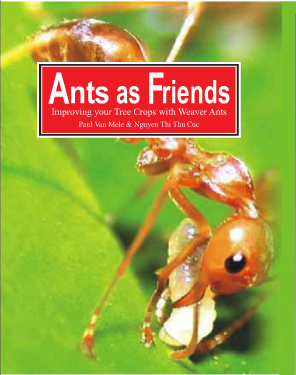
Attic
Ants as Friends: Insect Pest Management on Tree Crops with Weaver Ants
 |
Dr Paul Van Mele, technology transfer specialist at WARDA, and Dr Nguyen Thi Thu Cuc, an entomologist at the Cantho University, have written a book that provides practical tips to make optimal use of the beneficial weaver ant, based on improved insights of underlying ecological principles. They combined the rich sources of scientific and farmers' knowledge into an attractive and colorful manual. It will appeal in particular to university students, NGO workers, extension staff and all those engaged in communicating science to farmers. You can download the book in three different languages directly from our website!
|
Ants as Food: Weaver Ants on the table
In many countries of South East Asia weaver ants are harvested as a source of high protein food and as cure against diseases. The tradition of eating ants is most prominent among people in Thailand. A recent study of Sribandit et al. published in ASIAN MYRMECOLOGY assesses the socio-economic significance of ant harvesting and evaluates its sustainability. Read more about the weaver ant harvest in Thailand.
Download PDF
Take a guided tour to www.antbase.net
 |
Follow us into the fascinating world of the ants and the breathtaking biodiversity of the antfauna of Borneo.
If you are new to this website and if you want to know more about our website and what it has to offer, have a look at our guided tour. If you are already familiar with our webiste - or if you just want to get an impression of the beauty of ants - just have a look at our photo gallery. |
Newly discovered subfamily Martialinae Rabeling & Verhaagh 2008 represents the sister lineage to all extant ants (Hymenoptera: Formicidae)





A new species of blind, subterranean, predatory ant, Martialis heureka, was discovered in the Amazon by Christian Rabeling (The University of Texas, Austin) and Manfred Verhaagh (Staatliches Museum für Naturkunde Karlsruhe) in the leaf litter of the Amazon rainforest near Manaus, Brasil. It belongs to the first new subfamily of living ants discovered since 1923, the Martialinae Rabeling & Verhaagh 2008, and is a descendant of one of the first ant lineages to evolve over 120 million years ago.
Our hearty congratulations go to the lucky researchers!
Read more and have a look at the pictures...




